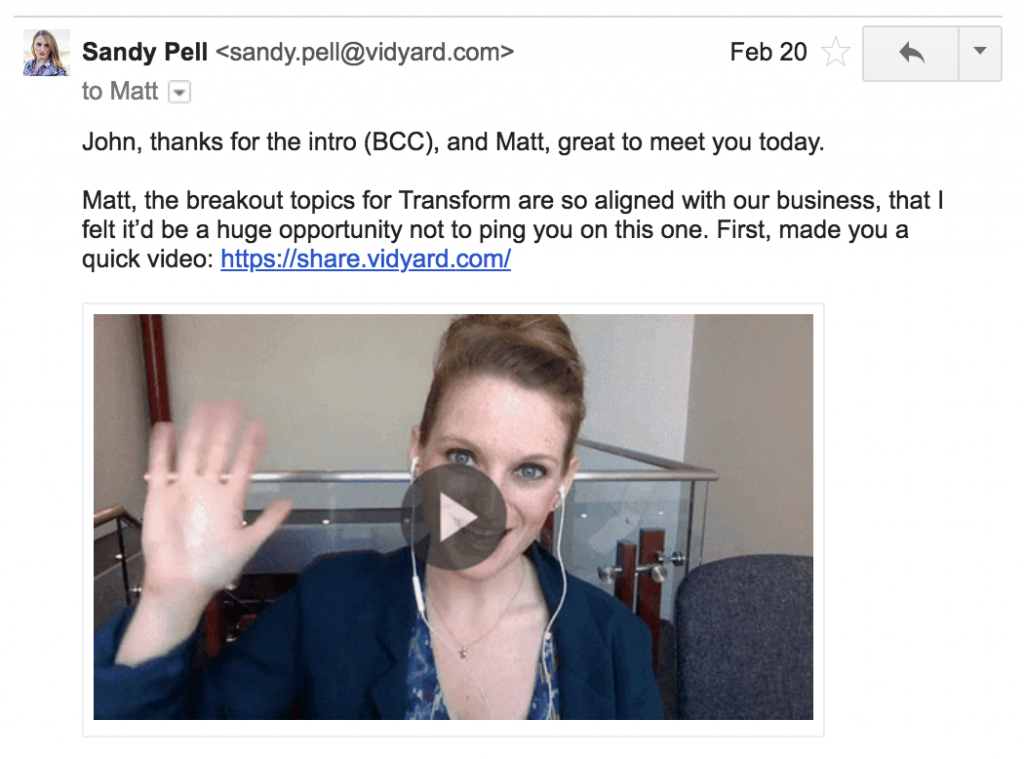They don’t have time to read through all the links you just sent them on the off chance that it might result in an interesting article or drive traffic to their website. Welcome to video pitching. That’s not to say that video pitching alone is a catch-all. Your pitch should still demonstrate that you’ve done your research on the publication and show how your piece would be of interest to their audience (or open them up to new readership). I have some tips and best practices that I’ve learned over the past year of experimenting with video pitching that I’m happy to share with you. 30 seconds seems like it would be short enough to hold the attention of a busy reporter, but long enough to show how you would add value to their publication. Pitching a speaker My first example comes from when I pitched our CEO for a big speaking engagement. To view this video please consider upgrading to a web browser that supports HTML5 Video In this subsequent example, I tried pitching the Twitter and LinkedIn universes on a recent product update, just to see what would happen. To view this video please consider upgrading to a web browser that supports HTML5 Video In fact, my first video was so successful, that I decided to do a few follow-up videos from the Call to Action conference, too. To view this video please consider upgrading to a web browser that supports HTML5 Video Bonus: (Another) speaking engagement pitch I know I already gave an example of pitching a speaker, but this one was too good not to share!
Journalists are inundated with a constant flood of pitches and press releases—and, as the Hustle’s Kendall Baker writes in his open letter to PR professionals, “they all suck.”
“Well, not all of them,” he concedes. “Some are fine. But the majority of the time, the pitches I get from you guys are downright awful.”
Ouch! What’s a savvy PR person to do?
The truth is, Kendall is right to give comms people a little tough love. Journalists are busy people and they’re sick of reading through copy-and-pasted messages or emails that have been blasted to hundreds of others. They don’t have time to read through all the links you just sent them on the off chance that it might result in an interesting article or drive traffic to their website. You need to give them a compelling reason why your story would add value to their publication, otherwise, they’re going to lose interest—fast, and you’re done
The good news is, I’d like to share my secret hack with you, and I can guarantee that it will help you “unsuck” your pitches. Welcome to video pitching.
Video pitching cures what so often ails the kinds of generic and impersonal messages that journalists like Kendall are so tired of getting. By nature, video is attention-grabbing and personal. In fact, when I first gave video pitching a trial run, my pitches received nearly 50% higher engagement than my text-based attempts Not only will you leave an impression, but allowing a reporter to “meet” you over video can open up opportunities for an ongoing relationship down the line.
(Speaking of leaving an impression, I may have given P.J. Bednarski, former Editor of Online Video Daily and VidBlog, a bit of a shock when he received one of my first video pitches. You can read all about it in my how-to post on video pitching.)
That’s not to say that video pitching alone is a catch-all. Just because you’re able to capture someone’s attention with video doesn’t mean you’re off the hook when it comes to adding value to their day. Your pitch should still demonstrate that you’ve done your research on the publication and show how your piece would be of interest to their audience (or open them up to new readership). Combine thoughtful outreach with the power of video and wait for the editors’ responses to come rolling in.
If you’re convinced that it’s time to give video pitching a shot—great! I have some tips and best practices that I’ve learned over the past year of experimenting with video pitching that I’m happy to share with you.
(Psst, if you don’t already have a screen-recording tool, now’s the time to download one. I love my company’s free Chrome extension, Vidyard GoVideo, for this!)
1. Do your homework
Each video pitch should be custom-tailored to its recipient, so be sure to do your due diligence. What types of articles does the publication you’re pitching to typically publish? What makes your idea a good fit? Why will their audience be interested?
2. Skip the script
You want to your pitch to engage your audience, but you don’t want to sound forced. I would recommend jotting down a few points ahead of time so you’re sure to hit on your key ideas, but otherwise, don’t plan what you’re going to say. Your message will seem that much more personal and genuine if it’s unrehearsed. If a fire truck drives by in the middle of your video, add a little joke in there like I did below. You’re real, and life around you is too.
3. Keep it concise
I always aim for 30 seconds max, but I also always tend to go over! 30 seconds seems…

COMMENTS